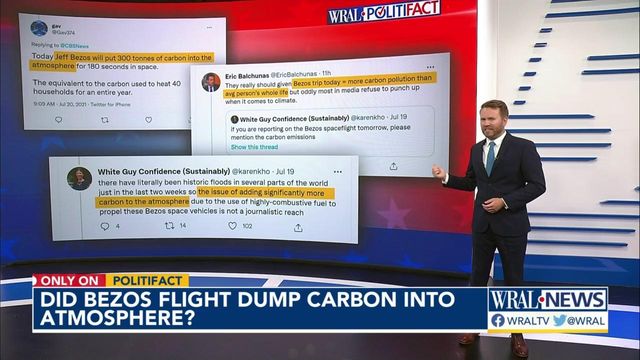Fact check: How much CO2 did Bezos' rocket dump into atmosphere?
When uber-billionaire Jeff Bezos blasted off from a launchpad in Texas for a fast and short trip to near-space, he ignited a burst of claims about the outsized carbon footprint of his adventure. PolitiFact checks those claims.
Posted — UpdatedWhen uber-billionaire Jeff Bezos blasted off from a launchpad in Texas for a fast and short trip to near-space, he ignited a burst of claims about the outsized carbon footprint of his adventure.
"Today Jeff Bezos will put 300 tonnes of carbon into the atmosphere for 180 seconds in space," said one tweet July 20. Other social posts made the same general point.
"If you are reporting on the Bezos space flight … please mention the carbon emissions."
"They really should given Bezos trip today = more carbon pollution than avg person’s whole life but oddly most in media refuse to punch up when it comes to climate."
In terms Americans might more clearly understand, the claim is that about 330 tons of carbon dioxide were emitted for Bezos and three companions to ride to a point about 60 miles above the Earth before coming back down. The round trip lasted about 10 minutes, of which about three were spent in weightlessness. Bezos, the founder of Amazon, is one of a handful of private rocketeers aiming to turn space travel into a viable business. His company is called Blue Origin.
Given the clouds of dust and fiery plume that come with any launch, it might seem likely that greenhouse gases would be part of the picture.
In the case of the engine used in the Blue Origin rocket, that assumption is wrong.
Conventional rocket fuels are carbon-based. The BE-3 engine developed by Bezos’ company burns liquid hydrogen and liquid oxygen.
"Carbon dioxide isn’t emitted from the Blue Origin rocket that was used for today’s launch," said Eloise Marais, an air pollution researcher at University College London.
At a press conference after returning from space, Bezos said the Blue Origin rocket used "the most environmentally benign propellant you can choose."
Other private companies — SpaceX, controlled by billionaire Elon Musk, and Virgin Galactic, which took owner Richard Branson into space a week before Bezos — use conventional fuels, and do release carbon dioxide.
PolitiFact ruling
Social media users tweeted that Bezos’ brief trip to space released 300 metric tons of carbon dioxide.
The trip released none. The rocket’s engine burns hydrogen and oxygen to carry it away from Earth. That doesn’t make these rides risk-free. They do pose a threat to the ozone layer.
We rate this claim False.
Related Topics
Copyright 2024 Politifact. All rights reserved.





